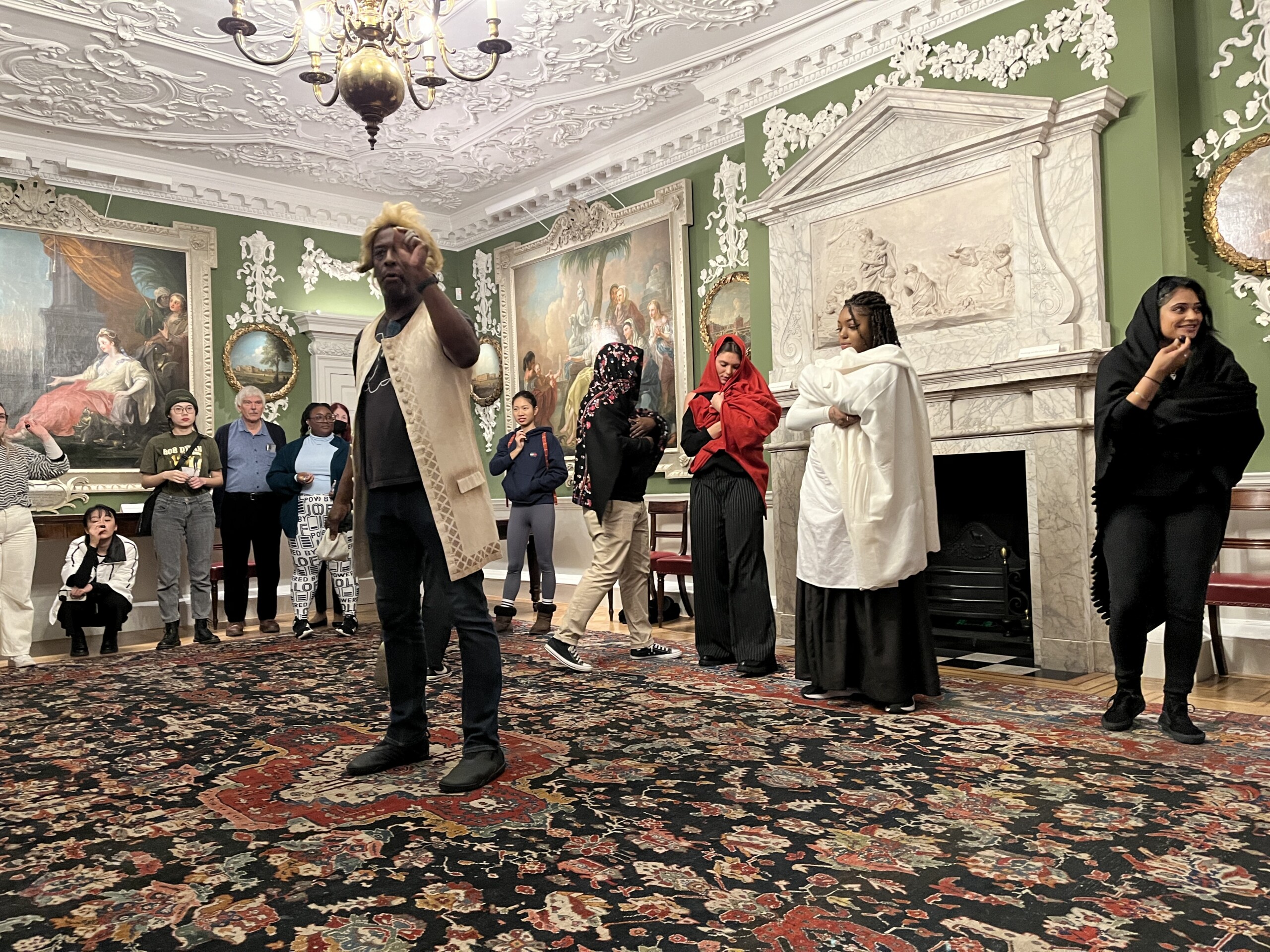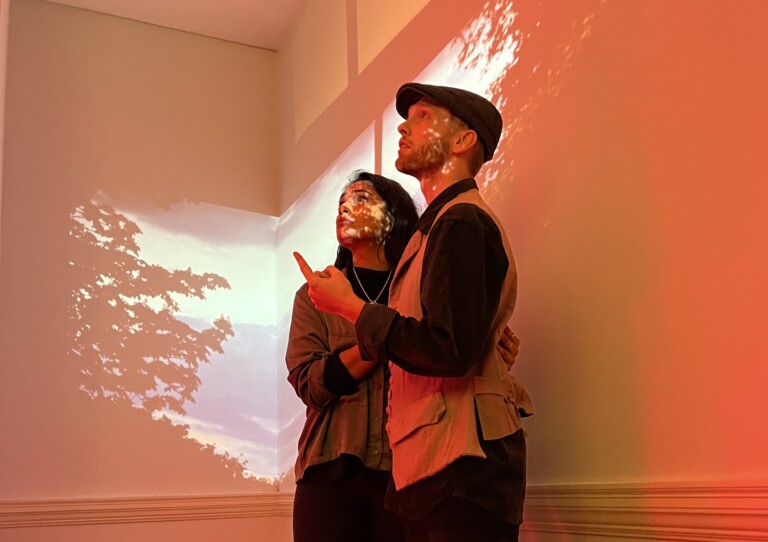By Dr Maggie Inchley, Dr Sylvan Baker and The Verbatim Formula Research Team
London, November 2022-
A dialogue between care-experienced young people and eighteenth-century philanthropists explores the arts and giving
The Verbatim Formula (TVF) is a collective research project in which academics work with care-experienced young people. As a research team, we use listening as a methodology and aesthetics of care. Since 2015, we’ve made events together, staging the testimony and creativity of young people with social workers, foster carers, and policy-makers, even performing at the Department for Education.
Along the way, our young co-researchers, aged 14-25, have used creative practices to share with us some of their deepest feelings. They’ve testified to what it’s like to become dependent on the state, to go through the system, to feel the stigma of care. They’ve told us how very difficult it is to envisage a university education, and of the meagre financial support that makes even attending college a stretch. As the cost-of-living crisis bites, life for these young people is only getting tougher.
Why are the arts so precious to these young people at this time? How can the arts help to make sense of entering or living in care?
TVF’s latest project, that we are undertaking with creative care-experienced young people from Wandsworth, is going to be a site-specific event in the Being Human festival this November at the Foundling Museum. As part of our preparations our intergenerational care-experienced research team visited the Museum, which is built on the original site of the Foundling Hospital, founded in 1739 by sailor and businessman Thomas Coram. Effectively the first ever children’s home in Britain, the Hospital took in children whose mothers could not care for them themselves. During our visit we walked through the Museum with our guide, Alice Chalk.
As we explored together the corridors, staircase, and splendid rooms of the Museum, Alice told us about the history of the original Foundling Hospital, and how Coram had managed to get a Royal Charter from George II, with the help of 21 Ladies of Quality and Distinction who signed his petition. Over decades, the well-connected Coram was able to call in philanthropic donations from wealthy donors such as banker Thomas Coutts and MP Arthur Onslow. As a team of creative researchers we were excited to discover how since Coram’s time, artists have played a key role in supporting its care of children.
The Museum is packed with art works from over the centuries, donated to the Hospital through history and up to the present day. In the grand and spacious Picture Gallery, a series of portraits make the patrons, resplendent in their finery, look stately and beautiful. The portrait of Coram, painted by his friend William Hogarth, shows the seaman as he was, informally portrayed without a fashionable wig. Coram’s one leg longer than the other is clearly shown. To our delight, we discovered that the painter had staged a lottery for his painting ‘The March of the Guards to Finchley’, giving 167 unsold tickets on the day of the draw to the Hospital. Not surprisingly, the Hospital won the painting, and it still hangs on display in all its satirical glory. Had Hogarth rigged the raffle deliberately? We admired the mischievous painter’s ingenuity and his particular form of creative philanthropy.
Ascending to the top floor of the Museum we visited the Gerald Coke Handel Collection, and relaxed in the ‘musical chairs’ that pipe snatches of Handel’s compositions. Alice pointed to copy of the composer’s will, rescued from fire at the last minute by his wife. In it Handel, who had written several works especially for performance in the Hospital, left it the rights to Messiah. It’s out of copyright now of course, but for years, any performance would make money so that the Hospital could continue its work, housing, feeding and educating the orphans that were brought to its doors, and sending them off to work as servants and soldiers, some of the boys trained as musicians themselves to play in the military bands.
Afterwards, excited by the prospect of making a performance in the Museum, we talked together as a research team. Our conversations were wide-ranging, about the failures of social care to provide dignity, about the position and feelings of children dependent on philanthropy, about the dire under funding of children’s care, and about the different ways that the arts can be understood in relation to giving and gifts.
Many of the challenges of the eighteenth-century resonated strongly. Where Thomas Coram observed poverty and mistreatment of infants, our co-researchers pointed to today’s failures to support young people undergoing ongoing trauma, as well as severe challenges of managing financially when leaving the system. Everywhere, young people are testifying that they are experiencing acute challenges around debt, housing, and buying basics, with the situation affecting mental health and their ability to build for the future (NLC Benchmarking Forum). As one of our co-researchers, Iona, put it very bluntly: it’s the poor, people in care, and asylum seekers who are hit the hardest, ‘unless you’re rich, you’re f****ed.’ She talked about the Maslow triangle with its hierarchy of fundamental human needs. These, she said, are not being respected.
And though many social attitudes have changed, a damaging stigma lingers around those young people who had no choice but to enter the care of the state.
Another co-researcher, Cameron, told us there is an ‘eternal struggle’ around how society perceives people who have been traumatised, with many people lacking empathy to take the time to fully understand other people’s circumstances. He was taken by the wall in the Foundling Museum that displays poet Lemn Sissay’s installation ‘Superman was a Foundling’ (2018), which aimed to draw attention to the disparity between the huge numbers of characters in literature that are fostered, adopted or ‘found’, and society’s tendency to disparage and stereotype those who in real life are actual ‘looked-after children’. For Cameron, art has the power to change people’s attitudes, but it can also be used to enforce stereotypes and social divisions. His own ambitions for a career in the arts is motivated not by the race for fame, but because he has ‘something to give that could be useful’. Whether it be by writing a play, a book, or a film, ‘I want to use the love, and the care and the compassion that I have to do something.’
For Violet, who paints and sings, her art is often personal, a way to process memories, or to celebrate her introductions to beloved artists like Ray Charles and Aretha Franklin by her foster carers. For Esha, another gifted singer, making music is a ‘mantra of me’, and performance is a ‘way of sending a message, a way to communicate’ that is different from the normal ways that are expected of her. For Melike, her poetry is writing ‘scriptures of my soul, everything that I am going to embark on, everything that my family has gone through’. It ‘sets a perspective in someone else’s eyes’, giving a challenge to the labels such as ‘vulnerable’ and ‘at risk’ that are hung around children’s neck when they enter care.
And what about the arts and philanthropy? Our co-researchers are critical of the idea that giving is a privilege of the rich, suspicious of the ‘celebrity philanthropy’ that is the modern equivalent of some of Coram’s donors. They know that many artists themselves are navigating the most precarious of livelihoods. For them personally, the arts themselves are precious, a gift that they can give to themselves and to others.
The arts we agreed afford ways to understand giving not only as a material or financial gift, but as sharing a moment of beauty or pleasure, a creative and caring act of kindness, a donation of time. As a fundamental need, artistic expression is far from the cherry on top; it is always present and necessary. ‘Everyone should have the basics’, Cameron told us, and more philosophically, ‘we need to be good’. His own art of creative philanthropic living?: ‘I want to do more good things than bad before I die’.

The Verbatim Formula team performed at The Foundling Museum on the 11th November 2022.
Lost and foundlings: exploring complex stories of care was part of Being Human festival
